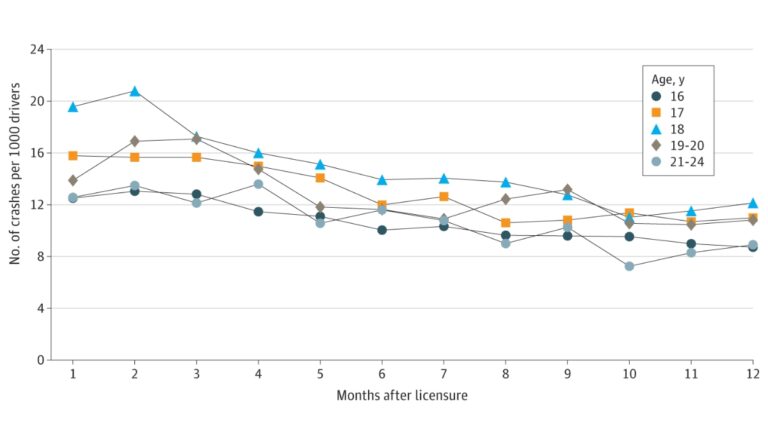Get Behind the Wheel
Drivers licensed at age 18 have the highest monthly crash rate of any age group in the first year after getting their license.

Read Time: 3 minutes
Published:
Getting a driver’s license is a momentous step towards independence for a teenager. While some eagerly get behind the wheel on their 16th birthday, others wait a little (or a lot) longer. The decision as to when a teen gets their license represents another milestone: they become at risk of getting into car accidents.
Teens who want their license before their 18th birthday must embark on the journey that is driver’s ed. Most states require a combination of classroom learning, behind-the-wheel training with an instructor, and 40 to 60 hours of supervised driving. Those who wait until they are 18 have far fewer requirements: once they have their permit, they can simply show up at the department of motor vehicles and take their driver’s test.
Elizabeth Walshe and colleagues wanted to know if the lack of undergoing driver’s ed training influences crash outcomes for young drivers licensed after their 18th birthday. Using Ohio licensing data and police-reported crash data of 130,000 drivers, they identified differences in crash outcomes by age for newly licensed drivers.
Drivers licensed at age 18 had the highest monthly crash rate of any age group in the first year after getting their license. The crash rate for 16-year-olds, the youngest age group, was 19% lower. And 17-year-olds had a 6% lower crash rate. These results suggest that behind-the-wheel training and drivers’s education helped 16- and 17-year-olds drive more safely and avoid crashes in the year after they turn 18. Crash rates for older age groups (19-20- and 21–24-year-olds) are also lower than for 18-year-olds, suggesting that crash rates eventually decrease with age.
Teenage drivers are at the highest risk of car crashes of any other age group. Although they only represent 3.5% of drivers, teens account for 8.9% of drivers involved in crashes. The assumption has been that the youngest teens, with their lack of experience and still-forming brains, are the most dangerous on the road. Eighteen-year-olds may feel older and wiser with their new licenses, but when it comes to driving they may be the most at-risk of all teenagers.
The researchers suggest that states should extend mandated education that includes behind-the-wheel training and driver education to 18-year-olds. The benefits of more experience and a little extra time before full independence on the road can reduce car crashes for these teens.
Databyte via Elizabeth A. Walshe, Daniel Romer, Abraham J. Wyner, et al. Licensing Examination and Crash Outcomes Postlicensure in Young Drivers. JAMA Network Open, 2022.



